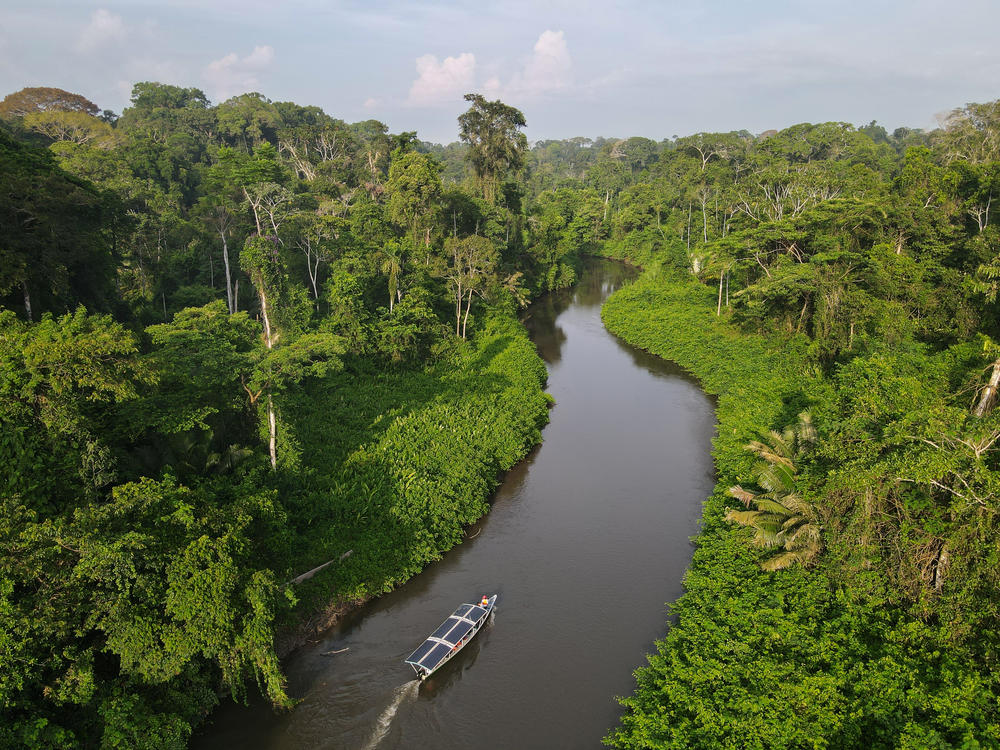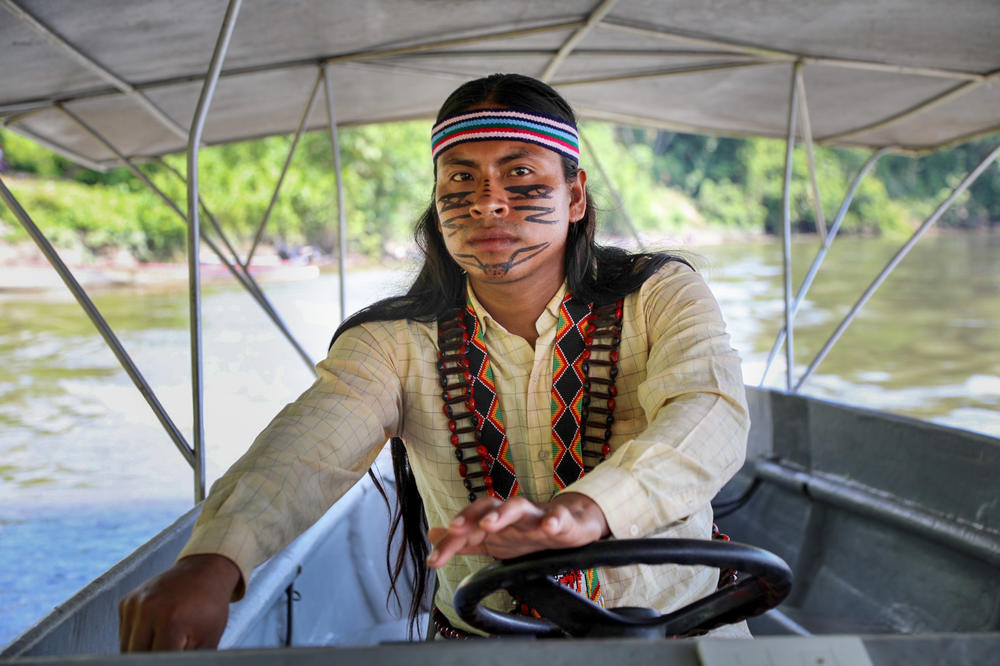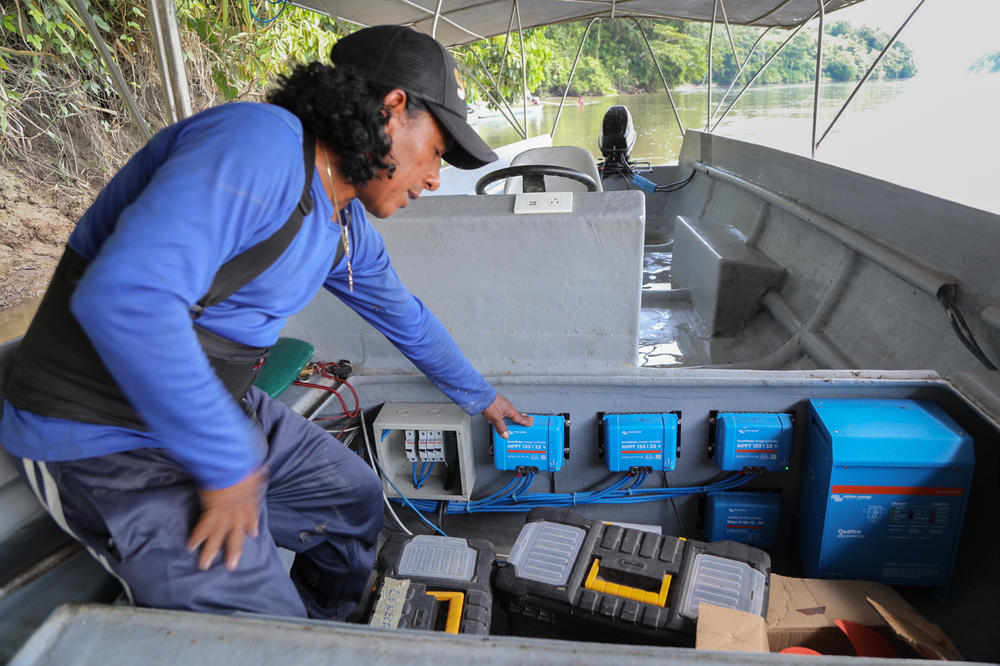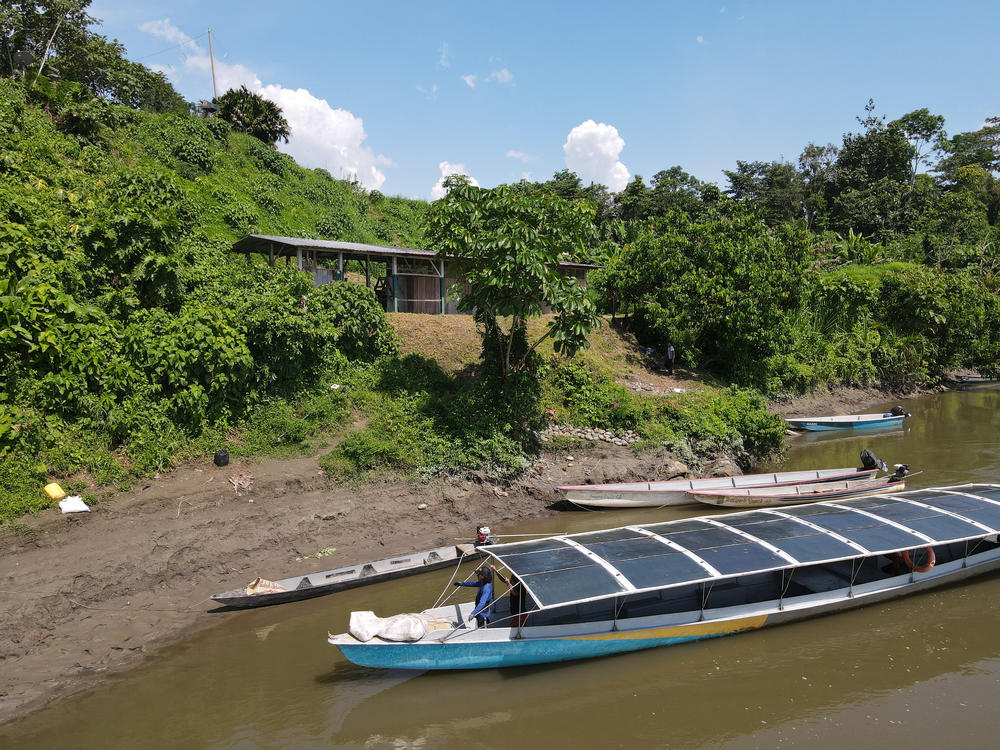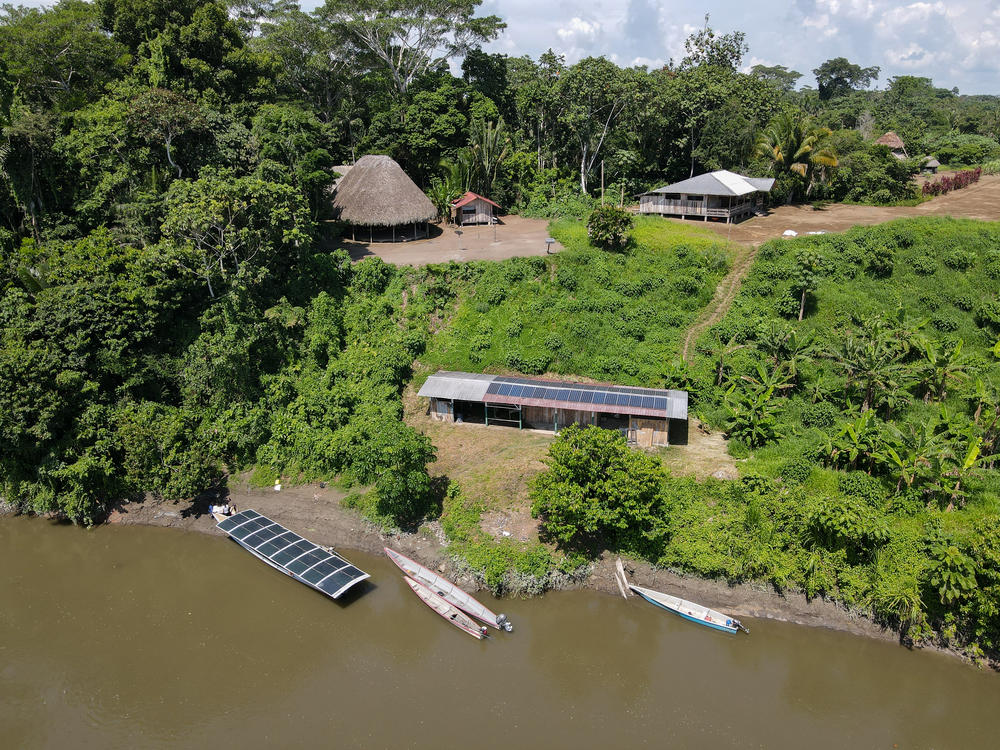Section Branding
Header Content
In Ecuador's Amazon rainforest, solar-powered boats are a boon for the trees
Primary Content
Shortly after sunrise, the students of Barrio San Luis begin their school run. Around a dozen girls and boys, wearing backpacks and carrying notepads in hand, hop down the muddy river bank and into the boat that provides their daily transport.
Their highway is the Rio Wichimi, a chocolatey brown river lined with towering, parrot-filled trees. It winds through pristine jungle deep into the Ecuadorian Amazon. And the fuel that powers their vessel – a large canoe with a roof of glossy black panels – is the fierce tropical sun.
"We don't have roads here," says Nela Atamait, a teacher accompanying the kids on their way downstream to a high school in the village of Wichimi. "So we travel by river, like our ancestors did. It's more natural and it doesn't destroy our forest."
Since 2016, the Indigenous Achuar people have navigated a fleet of solar-powered boats along the Amazonian waters of eastern Ecuador, enabling them to sell wares at markets, carry out administrative tasks in cities, monitor for illegal loggers, ferry around wildlife-spotting tourists and study at school.
The project, set up by the Ecuadorian nonprofit Kara Solar and staffed on the ground by Achuar people, is a showcase for sustainable infrastructure development in the Amazon rainforest, an ecosystem that is quickly disappearing amid road-building and development.
Since the turn of the century, Ecuador has lost about 2.3 million acres of tree cover, which is about 5% of its previous total and larger in size than Yellowstone National Park, according to Global Forest Watch, an independent monitor. Road construction plays a significant role in that deforestation, both directly and indirectly: A study of 332 Indigenous lands in the Amazon published in June found for every mile of road built unofficially (such as for illegal mining), about 14 acres of forest are lost.
"Mining, logging and extraction of natural resources like oil require the building of roads, which cause pollution, deforestation and brings outsiders that can dilute local cultures," says Sofía Jarrín Hidalgo, Ecuador adviser for the non-profit Amazon Watch.
In an effort to minimize that destruction, Kara Solar is investing in what it describes as the "ancestral highways" of the rainforest: rivers. By pairing nature's pre-built infrastructure with solar energy, it believes the livelihoods of communities across the Amazon can be greatly improved with minimal environmental impact.
Tapping into tropical sunshine
River travel across the region, usually via gasoline-powered canoes known locally as "peque-peques," can be expensive because fuel must be flown in by plane – increasing the cost of gasoline to as much as five times more than in the capital Quito. Hence, the allure of harnessing the limitless rays of the Amazonian sun.
To date, Kara Solar has built six electric boats – serving nine communities and hundreds of passengers along 60 miles of routes in Ecuador. Four solar centers charge the boats – supplementing the onboard solar panels – and also provide power for lighting and internet in Indigenous villages.
"The technology has been important, it is helping us to have autonomy," says Nuntu Canelos, an Achuar who leads Kara Solar's operations on the ground.
The boats, inspired by traditional Indigenous designs, vary in size and can carry up to 20 passengers. With electric motors and roofs covered in solar panels, they can travel at 10 to 12 miles an hour for up to 60 miles. Each cost between $25,000 and $40,000, most of which was provided by U.S.-based foundations such as the Inter-American Development Bank. Kara Solar says that with technological advances, prices are coming down.
"We want to show that another way is possible," says founder Oliver Utne. He arrived in Ecuador from the United States in 2007 and came up with the idea for solar-powered boats after witnessing the deforestation caused by road construction in the Achuar's territory.
Development without deforestation
The Achuar have inhabited Ecuador's rainforest for many generations in careful balance with its ecosystems. Now they find themselves pulled in two directions: toward both conservation and development. On the one hand, they are keenly aware of the deforestation, pollution and loss of biodiversity caused by building roads on their 1.6 million acres of land. On the other, these long-underserved communities want to improve their livelihoods and to travel, trade and communicate more easily.
"It's vital we improve infrastructure and provide alternative incomes for Indigenous people in ways that don't rely on depleting natural resources," says Hidalgo.
The tension of development versus conservation is playing out across the Amazon and other tropical rainforests globally. But Utne believes if Indigenous communities are supported with "clean transport networks and technological independence" then they will be better equipped to resist pressures to degrade their ancestral lands.
There are signs that this alternative vision could be working. Kara Solar estimates that the fleet of solar boats has completed more than 2,000 journeys, racking up tens of thousands of miles of solar-powered river travel across the region.
In Sharamentsa, one of the main ports along the Rio Pastaza, the solar boat has proven particularly useful. Achuar have used it to transport tourists drawn to the rich biodiversity, which includes jaguars, toucans and endemic butterflies. They also relied on the solar boats during the pandemic, when a months-long halt on flights meant that gasoline could no longer be flown in.
"Every single day I was driving the boat, everyone was asking me for help," says Luciano Peas, a 27-year-old Achuar skipper who was trained by Kara Solar. "They said: 'I need to go to my farm. I need to visit my parents. I need to go for medical treatment.' "
Defending the Amazon
The Achuar also say they used the solar-powered boats to monitor and guard their forest during the pandemic, which saw an influx of loggers working for Chinese companies in search of balsa trees and their valuable, lightweight timber.
"Some communities let the loggers take wood because it was a tough time and they needed money," says Peas. But Sharamentsa's greater autonomy, in part thanks to their solar boats, enabled them to push back against the loggers. "We didn't sell our trees. We work for ourselves and we must defend our territory."
Even some residents without direct access to a river say they are seeing the benefits of solar transport. In the community of Karakam, a hike through the jungle from Wichimi, people say they believe sustainable transportation will help them preserve their traditions and culture.
"We are defenders of the Amazon," says Vincente Mukuchan, a 42-year-old wearing a toucan-feather headdress. "If we can have a good quality of life without gasoline, we are ready and open to embrace it. We want our sons to continue our ways of life."
As a result, the solar boats have won growing support.
"I don't want highways [because] trees will have to be cut down," says Esperanza Sharimit, a 63-year-old resident living in a traditional thatched hut in Wichimi. "Now the air is pure here. We don't have pollution. There's no noise from cars. It's beautiful."
Getting residents' buy-in has been a fundamental goal for Kara Solar. The project began with a decade of discussions with Achuar communities before the first solar boat set sail, and is still led and inspired by the Indigenous groups.
Kara Solar's project is reminiscent of a tale from Achuar mythology about a "fire canoe" resembling an electric eel that carries the forest animals on its back along the river – heralding an age of health and prosperity. The nonprofit itself takes its name from the Achuar language: Kara means "a vision that becomes real."
"Our ancestors have always lived in the rainforest and we must take care of it," says Wakiach Kuja, president of Nacionalidad Achuar del Ecuador (NAE), an organization representing all of the 89 Achuar communities in Ecuador. "If we construct roads, it will change everything. There will be problems. Why not use eco-friendly machines?"
Not all Achuar, however, have been won over by the idea of a solar-powered future. Tiyua Uyunkar, former president of NAE and current prefect of the province of Morona Santiago, flew to China in September for a business meeting with a construction company to discuss "the generation of road projects" in the region.
Tiyua Uyunkar did not respond to multiple requests for an interview.
A few hiccups but lots of hope
Kara Solar is also working against the currents of convenience. The solar boats are considerably slower than gasoline-powered boats, meaning that many still prefer the latter for important or urgent matters. And given the new technology, breakdowns and technological hiccups are still an issue.
But with time, Kara Solar says reliability will improve. And it has created a roving team of eight Indigenous technicians to address any mechanical issues; they travel to communities to carry out repairs. Eventually, they will assemble boats. "We like to produce things ourselves, without relying on others," says Walter Washikiat, the lead technician.
Further advances are in the works, too. Washikiat says new boats will no longer have panels on their roofs but instead will be run by changeable batteries that can be charged separately, reducing turnaround times. A smaller, more maneuverable motor is also being developed, which would allow boats to more easily navigate the obstacle-strewn rivers.
Washikiat's goal is to have a solar boat and charging center in every riverside Achuar community. He has already helped deploy solar vessels in other countries, including Peru, Brazil, Suriname and the Solomon Islands.
"We can keep on multiplying," he says.
But for now, the Achuars' experience provides a glimpse of a solar-powered future in the Amazon rainforest.
Along the Rio Wichimi, a solar boat carrying a handful of passengers weaves through the steamy dense rainforest filled with squawking parrots and howling monkeys on its weekly trip to Puerto Nunkui, the nearest marketplace and transport hub.
Wilfrido Kawarim, an Achuar and a government official, is using the solar boat for the first time after visiting a remote community in the rainforest for outreach work.
"It creates less pollution and it's less noisy," he says. "It is a beautiful idea."
Peter Yeung is a freelance journalist who covers climate, global health, migration, human rights. He has written for the BBC, The New York Times, National Geographic, The Guardian and NPR, among others.
Copyright 2023 NPR. To see more, visit https://www.npr.org.
